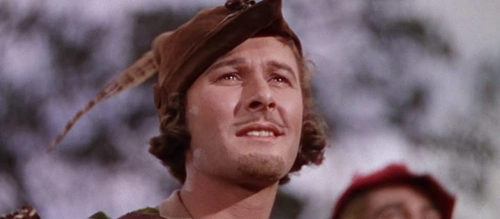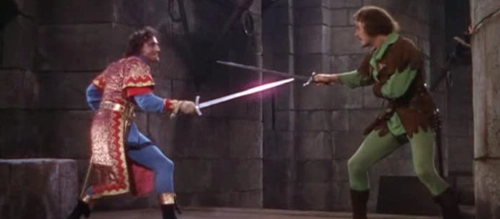‘The Adventures of Robin Hood’ at 85 – Review

The Adventures of Robin Hood (1937)
Directors: Michael Curtiz, WIlliam Keighley
Screenwriters: Norman Reilly Raine, Seton I. Miller, Rowland Leigh
Starring: Errol Flynn, Olivia de Havilland, Basil Rathbone, Claude Rains, Una O’Connor, Patric Knowles, Eugene Pallette, Alan Hale Sr., Melville Cooper, Ian Hunter, Herbert Mundin, Montagu Love
Before Russell Crowe and Ridley Scott played it as a gritty class uprising blockbuster, and every other attempt became grey and indistinct, Robin Hood films used to be fun. Incredibly, now 85 years old, The Adventures of Robin Hood was a crown jewel in the 1930s and remains impressive even today.
Sir Robin of Locksley (Errol Flynn) chooses the life of an outlaw, fighting on behalf of his Saxon brethren against oppression at the hands of the Norman nobility led by Prince John (Claude Rains) and Sir Guy of Gisbourne (Basil Rathbone). When the King of England, Richard the Lionheart (Ian Hunter), is captured returning from the Holy Land Crusades, John and his sycophantic supporters use their king’s captivity as a tenuous excuse to increase taxation and plan to crown him in his brother’s stead. Only Robin Hood and his gang of rebels in Nottingham stand to liberate all of England from tyranny.
This is one of the finest, most dazzling examples of filming in then-revolutionary three-strip Technicolor, using every camera the company had available over the course of their film shoot. Compare it to Errol Flynn and Michael Curtiz’s previous collaboration, the swashbuckling pirate adventure Captain Blood (1935), which has just as much dynamism in its fight scenes and probably just as much attention to period detail but doesn’t pop in quite the same way in black-and-white. The set dressing and costumes here are so eye-catching and more than justify the move to the new medium of colour film. The sheer ambition of building an accurate medieval Nottingham Castle as a full-scale set is mind-boggling in an age of CG-extensions, but it does add an invaluable tactility to the historical action.
Errol Flynn was a born star and a genuine Golden Age action hero but also a loose cannon, and his relationship with director Curtiz was famously volatile. His boisterous personality and old-fashioned, theatrical physicality was perfect to embody this kind of straight arrow (pun intended), brave and bold defender of the people. Modern audiences might struggle to keep a straight face with all the camp hands-on-hips chuckling and thigh-slapping that had since been spoofed affectionately and otherwise in such movies as Robin Hood: Men in Tights and Shrek, but it fits the slightly heightened reality of the film perfectly.
There really isn’t a weak link in the cast, from Flynn and Olivia de Havilland bringing no-acting-required chemistry to Robin and Marian’s romance to scene-stealer Una O’Connor as Marian’s protective lady in waiting Bess. Standing in for the baddies that we love to boo and hiss you get the casual cruelty of Claude Rains’ Prince John, the more cool and calculated malice of Basil Rathbone’s Guy of Gisbourne, and entertaining displays of corruption and cowardice from Montagu Love’s Bishop and Melville Cooper’s Sheriff of Nottingham.

As impressively mounted as the battles are and as memorable as many of the film’s images are, it’s easy to be caught off guard by just how funny this version of Robin Hood can be. Blockbusters before they were blockbusters (which this was, making back almost double its $2 million budget) aimed to please crowds with a bit of everything – excitement, romance, spectacle and plenty of humour. Robin verbally sparring with the nobility in addition to drawing his sword or releasing an arrow at them (“You speak treason” / “Fluently”) is a strategy deployed throughout, and in a particularly fun moment while escaping from his beloved Marian’s tower after a late night tryst, Robin debates for a while which of the guards in the courtyard below will best cushion his fall, in the end settling for the group standing in a circle talking. Having jokes and asides doesn’t cheapen your material, it merely keeps it from getting too monotonous.
The most iconic scene other than the archery contest featuring Robin beating an unbeatable shot by splitting an arrow down the middle (a feat actually achieved in-camera, but not by Flynn) is the climactic sword duel between man in green and the crafty Guy of Gisbourne (accomplished fencer Rathbone definitely had to dial down his skill level in the sword fights to make Flynn look better). Pretty much every movie sword fight since from The Princess Bride to the Star Wars Prequels has been chasing the speed, dexterity and character interplay shown here, their clash throwing exciting expressionist shadows against the castle walls, with the good guy showing chivalry by giving his opponent his sword back after a fall and the bad guy cheating to win.
This film’s take on this iconic character, especially Flynn’s performance, is so memorable that Robin Hood was voted the 18th greatest hero in Hollywood film by the AFI. And yes, it is this movie’s fault that we have confusingly sexy foxes courtesy of Disney’s animated remake with anthropomorphic animals that came along 40 years later.
We’re likely never going to see a production like this again. This was back when the only way to do an epic battle scene between hundreds was to have hundreds of costumed stuntmen (record-breaking at the time) acting out a complicated melee on screen, and the easiest way to have your hero release volleys of arrows at the baddies was to pay your extras wearing extra padding a bonus for each time they were actually hit by the professional archer employed on the film.
The Adventures of Robin Hood is rightly regarded as the definitive version of this centuries-old English folklore story, and in addition to timeless themes of fighting inequality through redistribution of wealth you get some fine performances, lush production design, thrilling sword fights, and (with Robin losing his arrow and some poor stuntman bracing himself for impact) one of the greatest sound effects of all time.
Score: 22/24


Good article, and refreshingly free of inaccuracies. Overlooked was the terrific, Academy Award-winning score by Erich Wolfgang Korngold.
Robert Florczak author of “Errol Flynn-The Illustrated Life Chronology”